NLIS 1
March 22, 2005
(Government Services)
The following is
being distributed at the request of the Petroleum Pricing Office:
Petroleum Pricing
Office uses interruption formula to move gasoline prices
Effective 12:01 a.m. Tuesday, March
22, 2005, the Public Utilities Board�s Petroleum Pricing Office (PPO)
will increase the maximum allowable price for gasoline by 4.1 cents
per litre (cpl), except in areas where a price freeze is in effect.
Following five days of escalating fuel prices on the New York
Mercantile Exchange (NYMEX) commodities market, which included
record prices for crude oil and gasoline, the criteria for the PPO
interruption formula were met for this automotive fuel and a change
is warranted at this time.
David Toms, PPO director (acting), said this pricing adjustment is
further evidence of the heightened instability that continues to
dominate the market. A major factor that�s currently escalating the
market prices for fuels regulated by the PPO is the high price of
crude oil, which briefly topped $57 US per barrel last week and has
remained above $50 US for nearly a month. This period represents the
longest stretch for which crude oil has exceeded the $50 US
threshold and is an unprecedented period in today�s market.
One of the many reasons pointing to high oil prices was the momentum
created during the days leading up to the March 16 meeting of the
Organization of Petroleum Exporting Countries (OPEC) in Iran when
market traders wondered what the cartel would do. The 11-member
group, responsible for approximately 40 per cent of the world�s oil,
determined that it would boost its production targets in an attempt
to ease high fuel prices. However, OPEC�s announcement did little to
allay fears that global demand for fuel would outstrip available
supplies.
As well, recent forecasts from OPEC, the U.S. Energy Information
Administration (EIA) and the International Energy Agency (IEA)
indicated that global demand for oil and its fuel products will grow
this year. Combine this with concerns about whether the availability
of oil and specific refined products will keep pace with or meet the
demand, and the resulting effect is increased pressure on fuel
prices.
When specifically looking at gasoline, inventories are above the
upper end of the average range for this time of year, though the
largest declines since September were reported in the March 16 EIA
report. Again, the high price of oil and anticipated demand are
driving the prices of this fuel in advance of the traditional peak
consumption season.
BACKGROUNDER
PPO benchmarks are established based
on the average prices of refined products in the
period since the last time maximum prices were established. The PPO
regularly sets maximum fuel prices on the 15th of each month.
For the interruption formula to be
used on gasoline and distillate fuels, the PPO requires the average
of market prices to be 3.5 cpl greater or less than the current PPO
benchmark
prices (except propane, which requires +/- 5.0 cpl) over five market
business days. As well, the interruption formula will only be used
five days after the last pricing adjustment, and as long as making
the change doesn�t interfere with the regular pricing schedule.
Illustrated in the following five graphs is the market-price
performance of gasoline, furnace oil and other fuels regulated by
the PPO for recent pricing periods up to March 18, 2005:
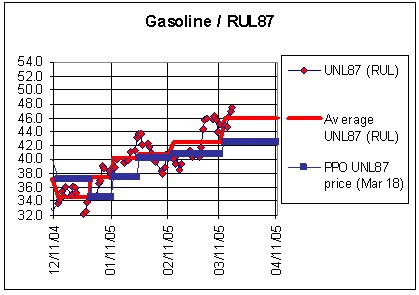
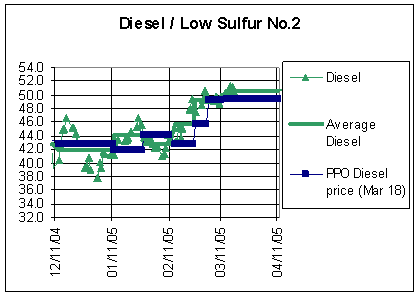
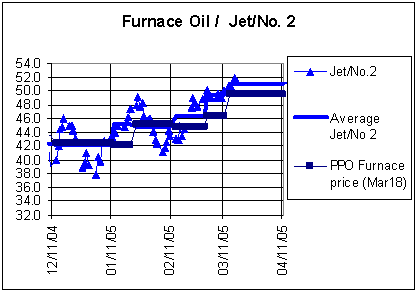
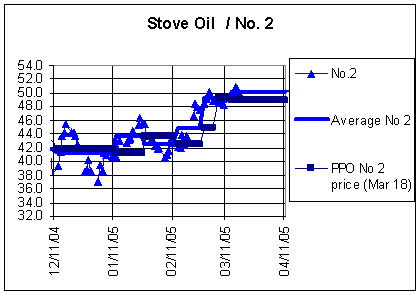
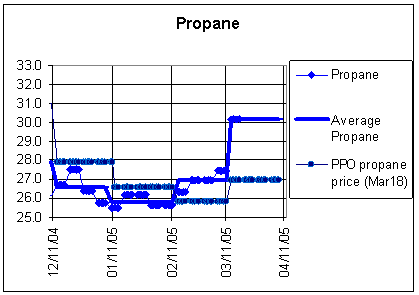
1. Automotive Fuels - Maximum Retail Pump
Prices - Effective March 22, 2005.
Media contact: Michelle Hicks, Communications, 1-866-489-8800 or
(709) 489-8837
2005 03 22
|









